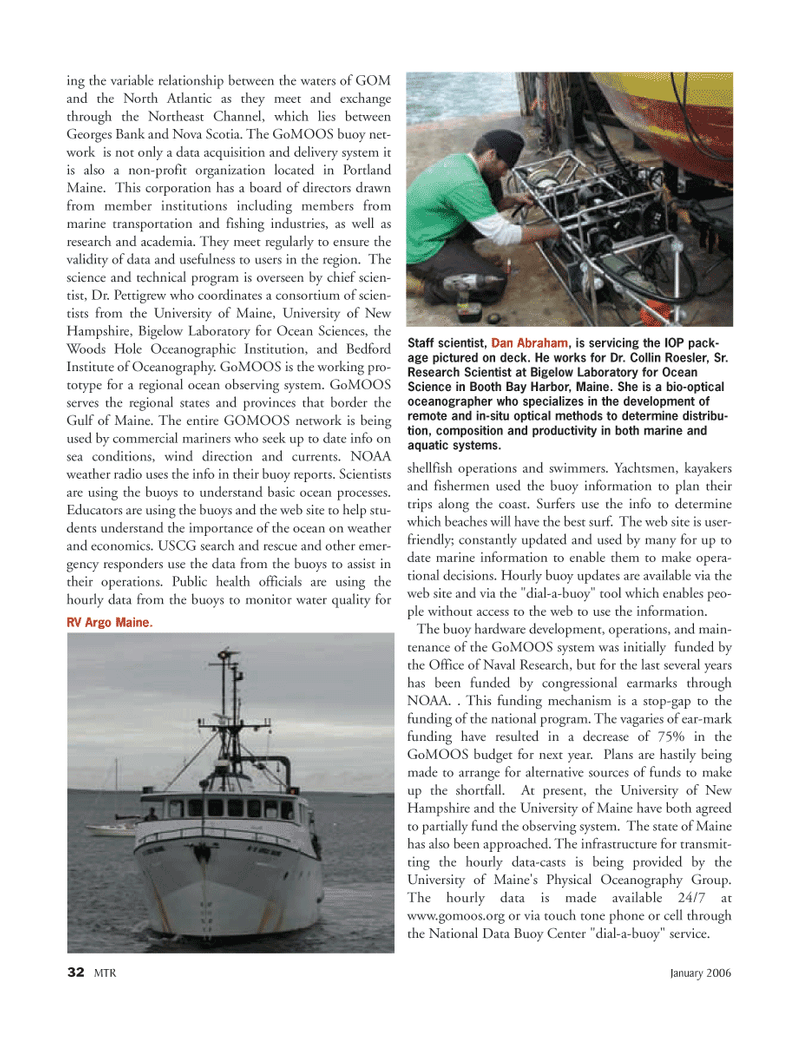
Page 32: of Marine Technology Magazine (January 2006)
Marine Science Institutions
Read this page in Pdf, Flash or Html5 edition of January 2006 Marine Technology Magazine
32 MTR January 2006 ing the variable relationship between the waters of GOM and the North Atlantic as they meet and exchange through the Northeast Channel, which lies between
Georges Bank and Nova Scotia. The GoMOOS buoy net- work is not only a data acquisition and delivery system it is also a non-profit organization located in Portland
Maine. This corporation has a board of directors drawn from member institutions including members from marine transportation and fishing industries, as well as research and academia. They meet regularly to ensure the validity of data and usefulness to users in the region. The science and technical program is overseen by chief scien- tist, Dr. Pettigrew who coordinates a consortium of scien- tists from the University of Maine, University of New
Hampshire, Bigelow Laboratory for Ocean Sciences, the
Woods Hole Oceanographic Institution, and Bedford
Institute of Oceanography. GoMOOS is the working pro- totype for a regional ocean observing system. GoMOOS serves the regional states and provinces that border the
Gulf of Maine. The entire GOMOOS network is being used by commercial mariners who seek up to date info on sea conditions, wind direction and currents. NOAA weather radio uses the info in their buoy reports. Scientists are using the buoys to understand basic ocean processes.
Educators are using the buoys and the web site to help stu- dents understand the importance of the ocean on weather and economics. USCG search and rescue and other emer- gency responders use the data from the buoys to assist in their operations. Public health officials are using the hourly data from the buoys to monitor water quality for shellfish operations and swimmers. Yachtsmen, kayakers and fishermen used the buoy information to plan their trips along the coast. Surfers use the info to determine which beaches will have the best surf. The web site is user- friendly; constantly updated and used by many for up to date marine information to enable them to make opera- tional decisions. Hourly buoy updates are available via the web site and via the "dial-a-buoy" tool which enables peo- ple without access to the web to use the information.
The buoy hardware development, operations, and main- tenance of the GoMOOS system was initially funded by the Office of Naval Research, but for the last several years has been funded by congressional earmarks through
NOAA. . This funding mechanism is a stop-gap to the funding of the national program. The vagaries of ear-mark funding have resulted in a decrease of 75% in the
GoMOOS budget for next year. Plans are hastily being made to arrange for alternative sources of funds to make up the shortfall. At present, the University of New
Hampshire and the University of Maine have both agreed to partially fund the observing system. The state of Maine has also been approached. The infrastructure for transmit- ting the hourly data-casts is being provided by the
University of Maine's Physical Oceanography Group.
The hourly data is made available 24/7 at www.gomoos.org or via touch tone phone or cell through the National Data Buoy Center "dial-a-buoy" service.
Staff scientist, Dan Abraham, is servicing the IOP pack- age pictured on deck. He works for Dr. Collin Roesler, Sr.
Research Scientist at Bigelow Laboratory for Ocean
Science in Booth Bay Harbor, Maine. She is a bio-optical oceanographer who specializes in the development of remote and in-situ optical methods to determine distribu- tion, composition and productivity in both marine and aquatic systems.
RV Argo Maine.
MTR#1 (17-32).qxd 1/9/2006 2:32 PM Page 32

 31
31

 33
33
